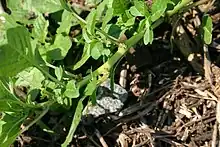Amaranthus blitoides
Amaranthus blitoides, commonly called mat amaranth,[1] prostrate pigweed,[2] procumbent pigweed, prostrate amaranth, or matweed, is a glabrous annual plants species. It usually grows up to 0.6 m, though it may grow up to 1 m (3 feet). It flowers in the summer to fall.
| Amaranthus blitoides | |
|---|---|
 | |
| Scientific classification | |
| Kingdom: | Plantae |
| Clade: | Tracheophytes |
| Clade: | Angiosperms |
| Clade: | Eudicots |
| Order: | Caryophyllales |
| Family: | Amaranthaceae |
| Genus: | Amaranthus |
| Species: | A. blitoides |
| Binomial name | |
| Amaranthus blitoides | |
It is believed to have been a native of the central and possibly eastern United States, but it has naturalized in almost all of temperate North America. It has also naturalized in South America and Eurasia. Some authorities list it as an invasive species.
Uses
The seeds of Amaranthus blitoides were used as a food source by a number of Native American groups.[3] Among the Zuni people, the seeds were originally eaten raw, but later ground with black corn meal, made into balls and eaten.[4]
References
- USDA, NRCS (n.d.). "Amaranthus blitoides". The PLANTS Database (plants.usda.gov). Greensboro, North Carolina: National Plant Data Team. Retrieved 7 January 2016.
- BSBI List 2007 (xls). Botanical Society of Britain and Ireland. Archived from the original (xls) on 2015-06-26. Retrieved 2014-10-17.
- UMich Ethnobotany
- Stevenson, Matilda Coxe 1915 Ethnobotany of the Zuni Indians. SI-BAE Annual Report #30 (p. 65)
- Everitt, J.H.; Lonard, R.L.; Little, C.R. (2007). Weeds in South Texas and Northern Mexico. Lubbock: Texas Tech University Press. ISBN 0-89672-614-2